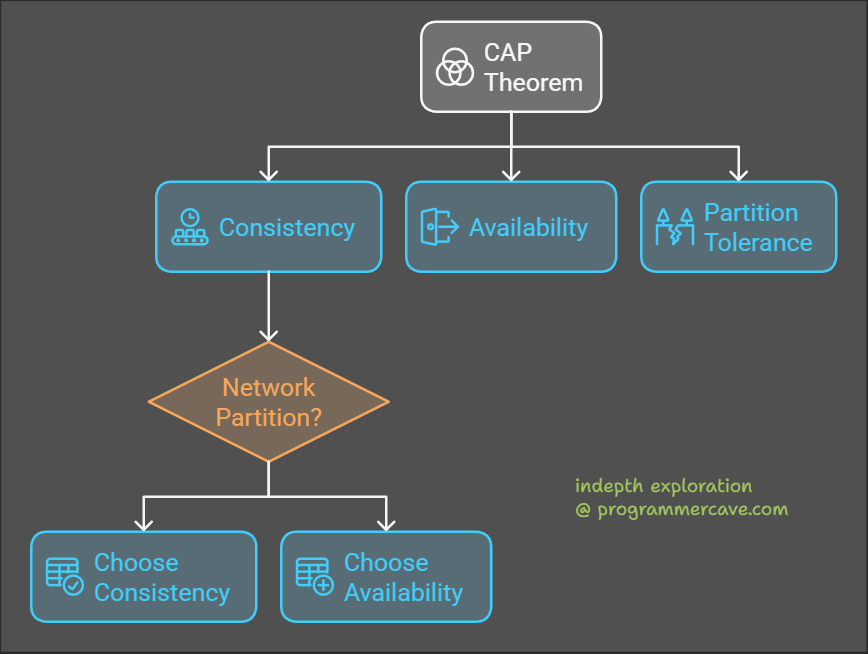Interview Question: Explain CAP Theorem
1. What is the CAP Theorem?
The CAP Theorem states that a distributed system can only guarantee two out of three properties at the same time:
- Consistency (C): All users see the same data simultaneously.
- Availability (A): The system always responds to requests (even with stale data).
- Partition Tolerance (P): The system works even if parts of it lose communication.
Key Insight: Network partitions (e.g., server crashes, dropped messages) are unavoidable. During a partition, you must choose between C and A.

2. Real-World Example: Rohit’s “Reminder” Startup
Imagine Rohit runs a company called Reminder where he writes down customer reminders in a diary. When he hires Raj to help, problems arise:
Problem 1: Inconsistency
- Scenario: Rohit writes a reminder in his diary, but Raj doesn’t update his copy.
- Result: Customers get inconsistent information.
[Client] --> [Rohit's Diary: "Call X"] [Client] --> [Raj's Diary: "No Entry"] - Solution: Both must write entries simultaneously to ensure consistency.
Problem 2: Availability Issues
- Scenario: If Raj is unavailable, Rohit can’t respond to requests until Raj returns.
- Result: Delays frustrate customers.
[Client Request] --> [Rohit: Available ✅] [Raj: Unavailable ❌] - Solution: Accept entries even if one person is missing, and sync later.
Problem 3: Network Partition
- Scenario: Rohit and Raj can’t communicate. The system must either:
- Reject requests (prioritize consistency but lose availability).
- Accept requests (prioritize availability but risk inconsistency).
Partition Occurs: [Rohit] --✂️ Network Failure ✂️-- [Raj] Choose: 1. Reject writes ➔ Consistency ✔️, Availability ❌ 2. Accept writes ➔ Availability ✔️, Consistency ❌
3. CAP Trade-offs: CP vs. AP vs. CA
| System Type | Prioritizes | Sacrifices | Example |
|---|---|---|---|
| CP | Consistency + Partition Tolerance | Availability | Banking systems (e.g., PostgreSQL) |
| AP | Availability + Partition Tolerance | Consistency | Social media (e.g., Cassandra) |
| CA | Consistency + Availability | Partition Tolerance | Single-server databases (e.g., non-replicated MySQL) |
⚠️ CA systems are theoretical – real-world distributed systems must handle partitions (P).
4. PACELC Theorem: Beyond CAP
The PACELC Theorem extends CAP to address normal operations (no partitions):
- PAC: During a partition (P), choose between A (availability) and C (consistency).
- ELC: Else (E), choose between L (latency) and C (consistency).
Examples
- Banking Apps: Prioritize consistency (e.g., ATMs must show accurate balances).
- Social Media: Prioritize availability (e.g., Facebook News Feed can show stale posts).
- Messaging Apps: Prioritize consistency (e.g., WhatsApp must show messages in order).
5. CAP in Popular Databases
| Database | CAP Type | Use Case |
|---|---|---|
| Cassandra | AP | High availability (social media, IoT) |
| MongoDB | CP (tunable) | Consistency-focused apps (e-commerce) |
| DynamoDB | AP (default) | Scalable web apps (Amazon) |
Key Takeaways
✅ CAP Theorem: Choose 2/3 properties during a partition.
✅ PACELC: Adds latency vs. consistency trade-offs in normal conditions.
✅ AP vs. CP: Match the system to the use case (e.g., social media = AP, banking = CP).
Further Reading: